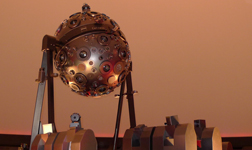Nagoya City Science Museum
TOP > Planetarium > About the Planetarium > Planetarium
Planetarium
An optical and a digital planetarium will be introduced.
Optical Planetarium

The sphere in the center of the dome, called the UNIVERSARIUM Model IX, is our optical planetarium.
This planetarium is able to replicate many astronomical phenomena including the accurate positions and brightness of 9,100 fixed stars visible to the naked eye, as well as the every-day motion of the planets and the phases of the moon.
Fiber optic wiring allows for more realistic and high-fidelity images of stars.
It has also made it possible to give stars natural sparkles.
Furthermore, our planetarium can reproduce starry skies seen from many places on earth such as cities and mountains in combination with other systems on the ground.
The projector for planets projecting the sun, the moon and planets is placed in the south side of the projector's sphere.
This allows for accurate positions to be shown on the sphere and many other functions to be performed, such as enlarging planet images.
The planetarium itself has various functions.
Starting in September, 2011, different will be introduced every month.
New functions will also be added to show many different images of the universe.
Digital Planetarium

This is the Sky Max DSII, whose projector can produce computerized stars over the entire surface of the dome.
In addition to the night skies of the present day, the skies of the future and past can also be reproduced based on data gained from the proper motion of 100,000 stars.
Also, since the universe is constructed a 3-D model, it can accurately replicate the positional changes of stars moving in space.
Working together with the optical planetarium, the Sky Max DSII can also complement with many videos the optically-produced celestial scenes, identical to those we see outside.
